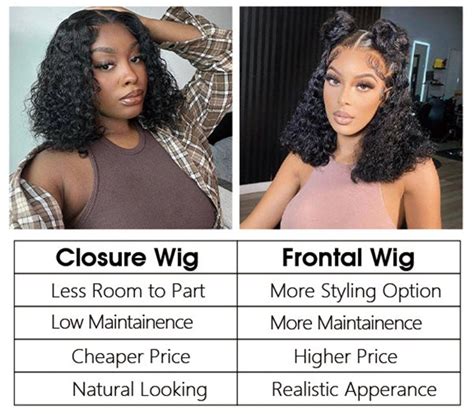Introduction
In the realm of hair extensions, two popular methods dominate the scene: frontals and closures. Both techniques offer unique benefits and drawbacks, making it crucial for aspiring hair enthusiasts to understand their differences before committing. This comprehensive guide will delve into the anatomy, pros, cons, and key considerations of frontals and closures, empowering you to make an informed decision that best suits your hair needs.

Frontal: An Anatomical Overview
A frontal is a large hair extension that covers the entire front hairline, extending from ear to ear. It is typically made of human hair or synthetic fibers and securely attaches to the scalp using adhesive or glue. The frontal creates the illusion of a natural-looking hairline, allowing for versatile styling options.
Closure: A Partial Cover for Versatility
Unlike a frontal, a closure is a smaller hair extension that only covers a specific section of the scalp, usually the top or crown area. Closures come in various shapes and sizes, including U-part, V-part, and 360-degree closures, which fully encircle the head. They attach to the scalp using clips, tape, or glue.
Pros and Cons: A Comparative Analysis
Frontals
Pros:
- Natural-looking hairline: Frontals provide a seamless transition between natural hair and the extension, creating a virtually undetectable result.
- Versatile styling: They offer endless styling possibilities, from intricate braids to sleek ponytails, allowing you to experiment with different looks.
- Long-lasting: With proper care, frontals can last up to a year or more, providing great value for your investment.
Cons:
- High maintenance: Frontals require regular touch-ups and maintenance, including washing, conditioning, and re-bonding the adhesive.
- Installation cost: Professional installation can be expensive, adding to the overall cost of the extension.
- Potential damage: Improper installation or excessive heat styling can damage natural hair or cause breakage.
Closures
Pros:
- Cost-effective: Closures are typically less expensive than frontals due to their smaller size and less complex installation process.
- Easy to install: Closures can often be installed at home using simple clips or tape adhesives, saving you the cost of a professional stylist.
- Less maintenance: Closures require less maintenance than frontals, as they do not cover the entire hairline.
Cons:
- Limited styling: Closures restrict certain hairstyles, such as those that expose the hairline or require parting the hair at the crown.
- Less natural appearance: The transition between closure and natural hair can be slightly noticeable under certain lighting conditions.
- Shorter lifespan: Closures generally have a shorter lifespan than frontals, lasting around 6-8 months with proper care.
Common Mistakes to Avoid
- Choosing the wrong type: Not all extensions are created equal. Carefully consider your personal preferences, scalp sensitivity, and desired style before selecting a frontal or closure.
- Over-tightening: Excessive tension when installing the extension can damage natural hair follicles or cause discomfort. Always follow the manufacturer’s guidelines for proper attachment.
- Neglecting maintenance: Regular maintenance is essential for extending the lifespan and preserving the quality of your extension. Schedule regular touch-ups and conditioning treatments.
- Using harsh products: Avoid using harsh chemicals or heat styling tools on your extension. These can weaken the hair and shorten its durability.
FAQs
- Which is better, a frontal or a closure? The best choice depends on your individual needs and preferences. Frontals offer a more natural hairline and versatile styling, while closures are more cost-effective and easier to install.
- How long do frontals and closures last? With proper care, frontals can last up to a year or more, while closures typically last around 6-8 months.
- Can I install a frontal or closure at home? While some closures can be installed at home, it is generally recommended to seek professional installation for both frontals and closures to ensure proper placement and avoid damage.
- How often should I get touch-ups? Touch-ups are recommended every 2-3 weeks for frontals and every 4-6 weeks for closures to maintain a seamless appearance and prevent slippage.
- Can I use any type of hair for frontals and closures? Most frontals and closures are made of human hair, but synthetic hair options are also available. Choose hair that matches your natural texture and color for best results.
- How much does a frontal or closure cost? Prices vary depending on the hair quality, type of closure or frontal, and installation method. Frontals typically cost more than closures.
Conclusion
Whether you choose a frontal or closure, these hair extension methods offer a transformative solution for enhancing your hairline and achieving your desired style. By understanding the differences between these techniques, you can make an informed decision that aligns with your hair goals and budget. Embrace the versatility and confidence that comes with a beautiful, customized hairline.
